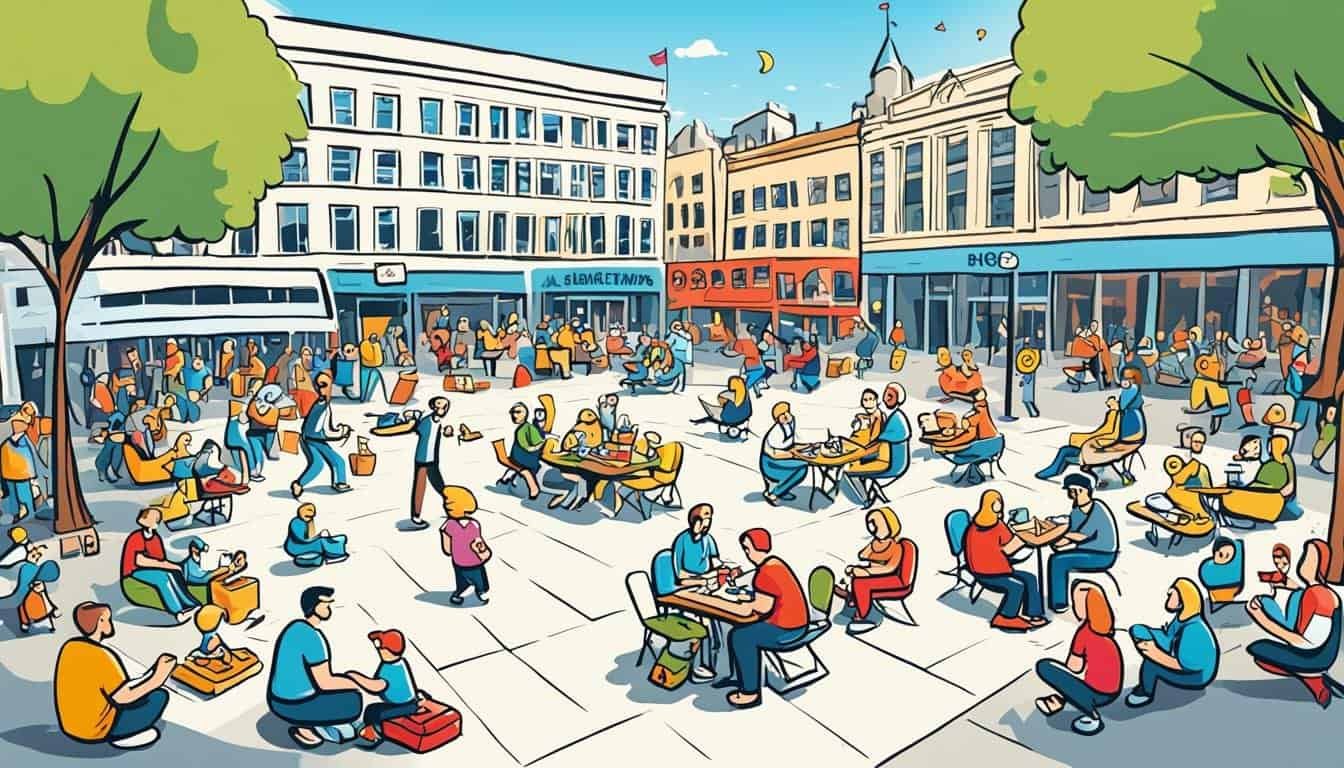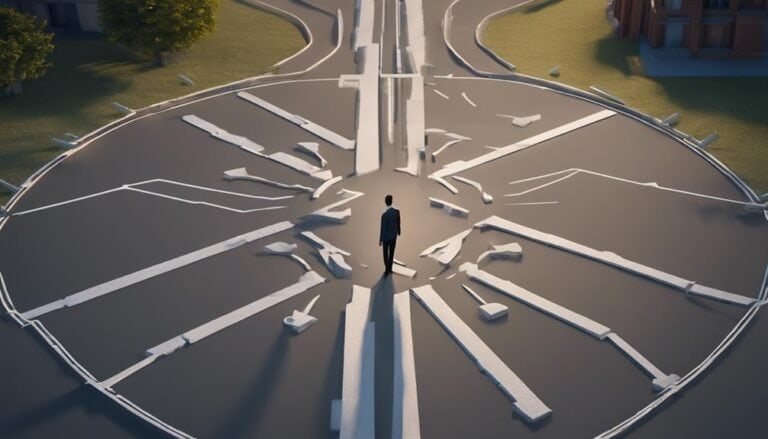Managing Public Space Conflicts
“We shape our buildings; thereafter, they shape us.” – Winston Churchill
This quote highlights the importance of managing public space. Today, these spaces are key for social, economic, and cultural activities. They can also cause conflicts. To solve these issues, we need good conflict mediation and strong community relations.
Public spaces reflect our community’s culture and how we interact with each other. For example, green areas and less traffic make cities healthier and cut down on pollution. But, making sure everyone gets to enjoy these green spaces is hard. The Covid-19 pandemic showed us how crucial healthy cities are, leading to new projects like bike paths and outdoor dining areas.
We must fight against unfairness in public spaces with designs that include everyone. Local authorities use different methods to check how safe and useful these spaces are. They focus on what benefits the community. Spaces need to keep changing to fit the needs of city dwellers, making them lively all the time. Projects like Project for Public Spaces in New York and the LAPIS project in Mexico show how thoughtful design can make public areas better for everyone.
Key Takeaways
- Urban spaces greatly affect how we see our community and interact with our surroundings.
- They should help reduce pollution and the urban heat island effect.
- It’s important to make green spaces available to all, especially in poor areas.
- Spaces that welcome everyone help equality and improve well-being.
- New projects after the pandemic have shown how cities can become more resilient and connected.
- Public spaces must always adapt to the changing needs of city life to stay inclusive and lively.
Understanding Public Space Conflicts
Public spaces in cities are key places where social and spatial dynamics happen. They are not just for social meetings but also show big changes in society. As cities grow and change, the issues in these areas get more complex.
Definition and Common Issues
An urban public space is any area that everyone can get to, like parks, plazas, sidewalks, and streets. These areas face many social conflicts because of different interests and activities. Some common problems include:
- Dealing with public protests, panhandling, and homelessness.
- Changes in city rules and how people use these areas.
- Control and privatization efforts that change how these areas work.
These conflicts show the ongoing debate between different groups. This includes city officials, property owners, local councils, merchants, street vendors, homeless people, unions, and activists. The book “Sidewalks: Conflict and Negotiation over Public Space” talks about these issues. It highlights how unique and public sidewalk spaces are.
Historical Context and Evolution
The history of public spaces in cities tells us a lot about today’s issues. Suburbs often skip public sidewalks to save money and avoid legal issues, making them less used because of car reliance. Downtown areas, however, are seeing more public spaces because of the trend towards city living. This change, along with the U.S. Surgeon General’s push for walking, has made pedestrian-friendly areas more popular.
Public spaces have always been where social conflicts show up, reflecting big changes in cities. They deal with issues like street vending and who gets to be there. As cities change, so do living styles and the pressure on public spaces. This means we need flexible and welcoming strategies for these areas.
Conflict Resolution Strategies
Dealing with conflicts in public spaces needs a mix of strategies. These methods help make cities peaceful, keep people happy, and follow the law.
Mediation and Dialogue
Mediation focuses on talking things out between people in conflict. It creates a space for open conversation. When people talk things through, they can find what they have in common.
It’s key to understand that everyone thinks they’re right. So, mediation should be done with empathy and by really listening. Studies show that bad communication leads to most workplace fights. Improving how we talk can make solving conflicts easier.
Law Enforcement and Legal Approaches
In cities, the law helps keep things in order. Police make sure rules are followed in public areas. But, just making laws isn’t enough to fix problems.
Using both laws and talking things out can lead to better solutions. Leaders need skills in solving conflicts and understanding people’s feelings to stop things from getting worse and find good solutions.
Community-Based Solutions
Community-led solutions believe locals know best how to fix their own problems. These efforts promote working together and being inclusive. When people in the community help make decisions, conflicts can be solved in a lasting way.
Training leaders to handle conflicts well is key. It helps make cities safe and welcoming for everyone.
Together, talking things out, using the law, and community efforts offer a full plan for handling public space conflicts. By balancing control and community involvement, cities can become better places for everyone.
Importance of Community Engagement
Getting local communities involved is key to solving public space issues. When residents take part in making decisions, it builds a stronger connection between them and their public areas. This makes spaces welcoming to everyone and meets different needs.
Community engagement helps in understanding how people feel and think. It encourages everyone to have a say in how things are run. This way, conflicts can be better handled and solved.
In cities like San Francisco, most police interactions with homeless people start with complaints from the public. This shows how important community input is in shaping city policies. In Portland, Oregon, a special team has helped reduce complaints about homeless camps. This shows how focused efforts in engaging the community can make a big difference.
Good public spaces are places where people feel supported and valued. They are democratic and meaningful, meeting people’s needs and encouraging them to interact with each other. In Syracuse, New York, the police work with local groups to help the homeless, reducing arrests and improving public areas. Eugene, Oregon, has a program that sends medics and mental health workers instead of police to help people in crisis, showing another way community engagement works.
When communities are engaged, they see public spaces in a new light. Places like parks and squares become community hubs, bringing neighbors together. These spaces draw more people and offer various activities, which can lead to more social connections. Successful public areas are inclusive, democratic, and meaningful, fostering a sense of unity. This underlines the crucial role of community engagement in managing public spaces well.
Role of Urban Planning in Managing Public Spaces
Urban planning is key in managing public spaces. It shapes how different social groups use and see these areas. The article “Managing Public Space: A Blind Spot of Urban Planning and Design” talks about this in Cities, volume 109, with the article number 103032.
Public spaces are changing due to issues like climate change, energy shift, and more. These changes need big physical and social updates. They also require a lot of money and a long-term plan.
Good urban planning and design of public spaces help people interact, get around easily, and stay healthy. For example, the EU’s Cohesion Policy (2021–2027) aims to bring people together. This makes cities better places to live.
We need more research on managing public spaces. The study looked at how the Netherlands manages its public spaces. It showed we need better strategies for managing these areas.
Being together in public spaces helps build community and social connections. Places like parks and streets in neighborhoods make people feel connected. This shows how important good urban planning is for public spaces.
Urban planners should focus on making public spaces that bring people together. This way, they can make cities that are safe, lively, and good for everyone.
Public Policy and Its Impact on Public Space Management
The link between public policy and managing public spaces is deep and far-reaching. It affects how cities work and change. Government strategies are key in making these spaces places of community or conflict. Knowing how these strategies work is vital for making cities that welcome everyone.
Government Initiatives
Government actions shape how we manage public spaces. Places like London’s squares and Hong Kong’s streets show this. Now, more public spaces are being looked after by developers, groups, and communities. This change brings both good and bad things.
Co-production is a new way that’s growing, especially when money is tight. It means working together in making, managing, and checking on public spaces. This way, costs and responsibilities are shared, making spaces that better fit community needs. But, these new spaces can also raise questions about who they belong to and if they’re really public.
Policy Changes and Trends
Changes in policy affect how we handle public spaces. Big cities face many challenges in making and managing these areas. Some challenges are about having enough space, others about how well these spaces serve people’s needs. Co-production helps by letting people have a say in making decisions, making sure spaces are right for the community.
Now, cities are moving towards giving more power to communities. This change shows a move towards being more open and giving power to local areas. The way we see who works on public spaces shows this shift. These changes show how important government decisions are in making public spaces what they are, affecting city life.
In short, looking at how public policy affects public spaces shows us complex interactions. These policies change how we use and see these areas. They show the need for flexible strategies to serve the many needs of city people. By understanding this, we see how good governance can turn public spaces into lively places for everyone.
Stakeholder Communication: Building Better Relations
Effective communication with stakeholders is key to peaceful urban living. By having *strategic dialogue* and using inclusive ways to talk, we can lessen conflicts and clear up misunderstandings.
Effective Communication Strategies
Good stakeholder communication means clear, consistent talks with everyone involved. It’s important to shape the message for different groups. For example:
- Customers might want more details on how projects will help them.
- Team members need updates on the technical side and progress.
Using emails, video calls, and meetings can make people feel more connected. Listening well, being honest, and open builds trust with stakeholders. Keeping track of what was said helps with checking back and staying on track.
Collaborative Approaches
Working together on *collaborative urban solutions* means getting everyone involved. This way, we hear from different people and make better choices. Some good ways to do this include:
- Figuring out what everyone needs, like residents, businesses, and government agencies.
- Creating spaces for everyone to share their thoughts and ideas.
- Encouraging talking and finding middle ground to solve disagreements.
Listening to feedback and being open to change helps build good relationships. Getting stakeholders involved early can spot problems and chances for growth. This makes projects go smoother and end well. Keeping up a *strategic dialogue* is key to making these teamwork efforts better.
Managing Public Space Conflicts Through Inclusive Design
Inclusive design is key in solving public space conflicts. It makes sure everyone feels welcome and can get around easily. This way, public areas become places where people can have fun together and avoid fights.
- Functionality and Flexibility: Designing spaces that accommodate various activities and user preferences.
- Accessibility in Public Spaces: Ensuring all individuals, regardless of physical abilities, can access and enjoy public areas.
- Community Engagement: Involving local communities in the design process to create places that reflect their needs and desires.
Research shows that when planners work with the community, conflicts drop by 60%. Using methods like participatory budgeting and charrettes helps. Also, 85% of conflicts get solved with participatory mapping, showing how important inclusive design is.
Accessibility in public spaces helps everyone feel equal and included. Things like ramps, tactile paving, and clear signs make sure everyone can use public areas. This makes public spaces better for everyone.
Using design solutions that include everyone helps make public spaces better for all. When we listen to the community and value different views, we get places that are peaceful and welcoming.
Case Studies on Successful Conflict Mediation
Conflict mediation is key to making public spaces peaceful and useful. By looking at real examples, we learn how to solve these issues.
Urban Areas
In cities, dealing with conflicts is complex because of many people and crowded areas. The High Line in New York City shows how tough spots can become loved places. It used community input and teamwork to solve problems, making sure everyone felt included.
Rural Settings
Rural areas face their own set of challenges in managing public spaces. The Blaenavon project in Wales is a great example. It turned an old industrial area into a UNESCO World Heritage Site with the help of local people and respect for history.
This shows how important conflict mediation is, whether in cities or countryside. With careful planning and working together, we can create places that everyone enjoys.
Conclusion
Managing conflicts in public spaces is complex and needs a mix of strategies. This article has covered many ways to solve these issues. It stressed the need for urban planning, policy making, talking to stakeholders, and getting the community involved. Public spaces are not just places; they are where people meet, reflect culture, and remember history. They should be safe and welcoming for everyone.
Adding public art, green areas with water, trees, and grass, and changing streets can help. These changes encourage people to talk and work together. In Zanzibar’s Stone Town, planners balanced tourism with local needs. The Downtown Streets Team showed how public spaces can tackle homelessness and reduce trash.
Looking ahead, we must keep up with changes in our cities. Cultural differences, economic issues, and social changes, like in Zanzibar, show we need a broad approach. By working together, using policies, and talking to everyone, we can make public spaces better. We must all work together to keep public spaces great for the future.
Source Links
- Getting public space right: transforming society from the ground up
- Uses & Activities: How to Create Multi-Purpose Places
- Urban public space between fragmentation, control and conflict – City, Territory and Architecture
- Sidewalks: Conflict and Negotiation over Public Space
- 5 Conflict Resolution Strategies
- Five Conflict-Resolution Strategies for the Workplace
- Three Ways Communities Can Promote Inclusive Public Space and Better Support People Forced to Live Outside
- Creating sense of community: The role of public space
- Managing public space: A blind spot of urban planning and design
- Understanding the Relationship between Urban Public Space and Social Cohesion: A Systematic Review – International Journal of Community Well-Being
- Providing Public Space in a Contemporary Metropolis
- Co-production of privately owned public space: Who, why, when, and how? – URBAN DESIGN International
- The Importance of Stakeholder Communication in Project Management | Sunscrapers
- Building Strong Stakeholder Relationships & How A SRM Can Help
- Identifying and Prioritizing Stakeholders and Publics
- Conflict Management in Planning
- Case Study of Conflict Management: To Resolve Disputes and Manage Conflicts, Assume a Neutral 3rd Party Role
- Conflict Resolution: Case Studies and Success Stories
- Appendix A: Case Studies
- Best Practices to Manage Public Spaces







